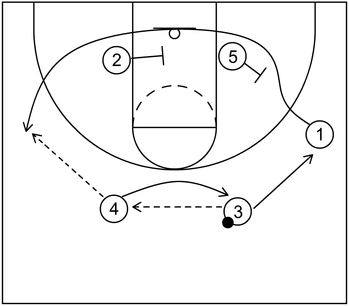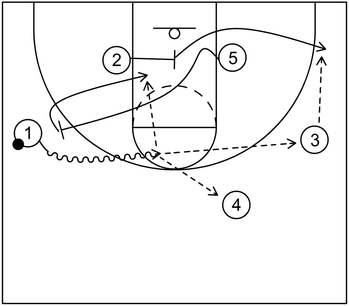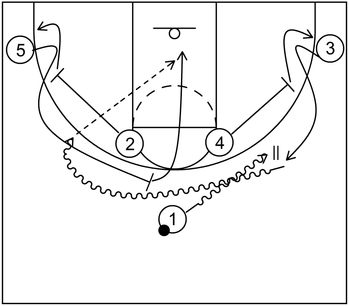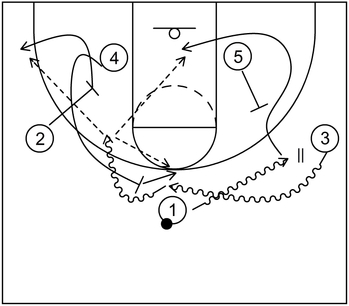What is the ram screen in basketball
The ram screen comprises offensive action that occurs when one player will set an off-ball screen for a second player and afterwards, the second player will begin to set an on-ball screen for a third player, currently in possession of the basketball.
Essentially, the initial off-ball screen for this sequence is the ram screen because it is immediately followed by the beginning intention of an on-ball screen from the player that received the off-ball screen in the first place.
However, if the player receiving the off-ball screen does not even begin to set a on-ball screen instantly following the initial screen, then the first screen would not be a ram screen in that case.
As an example, if the initial screen is a down screen which is followed by an on-ball screen from the player that received the down screen, then for that instance, the initial down screen is also known as a ram screen.
On the other hand, if the initial screen is a down screen but it is not directly followed by an on-ball screen from the player that received the down screen, then the initial down screen would not be a ram screen in that scenario.
Furthermore, it should also be noted that the player that received the initial screen (i.e. the ram screen) does not necessarily have to fully set the on-ball screen. However, there should at least be a beginning intention, as previously stated, in terms of cutting towards the player with the ball as if to set the on-ball screen.
In other words, there could be a possible occasion in which the player that received the ram screen could then set what is generally known as a ghost screen, a type of fake screen.
For example, the player that receives the ram screen could approach the player with the ball as if to set the on-ball screen (i.e the beginning intention) but then, that same player could cut to another area of the court that is away from the ball without totally setting the on-ball screen.
For this case, the ram screen would still be valid because there was at least an initial intention to set the on-ball screen.
Why is the ram screen a potentially effective action
The ram screen is a potentially effective action because it could mitigate certain ball screen counters by the defensive team, especially the defensive hedge tactic that could be executed by the screener’s defender.
Essentially, with the hedge tactic, the screener’s defender will typically lift above the on-ball screen to block the intended dribbling pathway of the player that would receive the screen.
This hedge action, in turn, makes the on-ball screen ineffective at best, and as a result of that, the screen receiver would not be able to create good dribble penetration, particularly towards the middle of the floor.
From there, the unprofitable on-ball screen and the subsequent lack of dribble penetration would equal limited or practically, zero scoring opportunities for the offensive team.
The ram screen attempts to counter the hedge defensive tactic by setting an off-ball screen on the screener’s defender before that same defender has an opportunity to get above the on-ball screen to implement an effective hedge.
In other words, when the potential hedger (i.e. the screener’s defender) gets caught on the initial off-ball screen or while the hedger is in the process of evading the off-ball screen, this would most likely reduce the amount of time that is needed to get above the on-ball screen to reduce its effectiveness with the hedge action.
From that point, the offensive team could get possible dribble penetration or execute other types of counters against the defensive team such as pick and pop action, Spain pick and roll, or double ball screens to create scoring opportunities.
What are examples of basketball set plays that use the ram screen
Example 1 – Part 1

This is an example of a box set basketball play that uses the ram screen derived from elements of Up-Tempo Transition Game by Andy Enfield.
To begin, 1 executes a dribble entry towards the right side wing and then, 3 cuts to the right slot via the down screen set by 5.
Also, as that occurs, 4 cuts to the left slot via the down screen set by 2. Following the initial screens, 3 receives the ball from 1 while 2 and 5 fill the recently vacated low post areas.
Example 1 – Part 2

Next, 4 receives the ball from 3. Afterwards, 1 cuts through to the left side wing via the screens set by 5 and 2. From there, 1 receives the ball from 4 to complete the reversal action and then, 1 could take the three-point shot if open.
If 1 is not open for the jump shot, then 3 could cut to the vacated right side wing while 4 fills the open right side slot area.
Example 1 – Part 3

After 3 and 4 cut to the right side wing and slot respectively, 5 receives a cross screen from 2, which in this case is also a ram screen. Immediately following that, 2 cuts to the right side corner while 1 dribbles toward the middle of the court via the on-ball screen set by 5.
From that point, 5 could roll to the basket, receive the ball from 1, and then score at the rim. Additionally, 3 or 4 could receive the ball from 1 and take possible jump shots if those are available.
Moreover, if 3 receives the ball but a jump shot is not open, then 2 could receive the ball from 3 and take the open jump shot as another possible scoring option.
Example 2

This is an example of a Horns set play that utilizes the ram screen to create a scoring opportunity, particularly near the basket.
To start, 1 dribbles toward the right side wing and as that happens, 3 cuts to the right side wing via the wide pin down screen set by 4.
Following that, 4 fills the right side corner while 1 executes a dribble handoff with 3. At the same time, 5 receives a wide pin down screen from 2, which is also a ram screen.
Next, 3 dribbles toward the left side via the on-ball screen set by 5 while 2 fills the left side corner. Afterwards, 5 rolls to the basket, receives the ball from 3, and then scores at the rim.
Example 3

This is an example of a 3 out 2 in set play that uses the ram screen to generate multiple scoring options. To demonstrate, 1 dribbles toward the right side wing to execute a dribble handoff with 3.
After that occurs, 3 dribbles back toward the top. Also, at the same time, 4 cuts toward the top via the down screen set by 2, which is the ram screen as well.
From there, 3 attempts to get dribble penetration in the gap near the left side high post area by way of the on-ball screen set by 4.
As that happens, 2 fills the left side corner, 4 fills the top, and 1 cuts to the basket via the back screen set by 5.
Next, 3 could pass the ball to either 1, 2, or 4 if those potential scoring options are available. In addition to that, 3 could also take the mid-range jump shot or dribble to the basket and score via a layup/dunk.